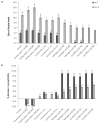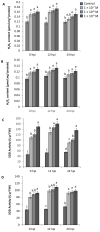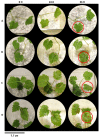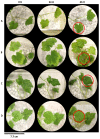Strigolactones GR-24 and Nijmegen Applications Result in Reduced Susceptibility of Tobacco and Grapevine Plantlets to Botrytis cinerea Infection
- PMID: 37765366
- PMCID: PMC10535315
- DOI: 10.3390/plants12183202
Strigolactones GR-24 and Nijmegen Applications Result in Reduced Susceptibility of Tobacco and Grapevine Plantlets to Botrytis cinerea Infection
Abstract
Priming agents are plant defence-inducing compounds which can prompt a state of protection but may also aid in plant growth and interactions with beneficial microbes. The synthetic strigolactones (±)-GR24 and Nijmegen-1 were evaluated as potential priming agents for induced resistance against Botrytis cinerea in tobacco and grapevine plants. The growth and stress response profiles of B. cinerea to strigolactones were also investigated. Soil drench treatment with strigolactones induced resistance in greenhouse-grown tobacco plants and restricted lesion development. The mode of action appeared to function by priming redox-associated compounds to produce an anti-oxidant protective response for limiting the infection. The results obtained in the in vitro assays mirrored that of the greenhouse-grown plants. Exposure of B. cinerea to the strigolactones resulted in increased hyphal branching, with (±)-GR24 stimulating a stronger effect than Nijmegen-1 by affecting colony diameter and radial growth. An oxidative stress response was observed, with B. cinerea exhibiting increased ROS and SOD levels when grown with strigolactones. This study identified the application of strigolactones as potential priming agents to induce disease resistance in both tobacco and grapevine plants. In addition, strigolactones may alter the ROS homeostasis of B. cinerea, resulting in both morphological and physiological changes, thereby reducing virulence.
Keywords: Botrytis cinerea; hyphal branching; plant fitness; reactive oxygen species; strigolactones.
Conflict of interest statement
The authors declare no conflict of interest. The funders had no role in the design of the study; in the collection, analyses or interpretation of data; in the writing of the manuscript; or in the decision to publish the results.
Figures








Similar articles
-
Hexanoic acid protects tomato plants against Botrytis cinerea by priming defence responses and reducing oxidative stress.Mol Plant Pathol. 2014 Aug;15(6):550-62. doi: 10.1111/mpp.12112. Epub 2014 Feb 14. Mol Plant Pathol. 2014. PMID: 24320938 Free PMC article.
-
Identification of genes involved in fungal responses to strigolactones using mutants from fungal pathogens.Curr Genet. 2017 May;63(2):201-213. doi: 10.1007/s00294-016-0626-y. Epub 2016 Jun 28. Curr Genet. 2017. PMID: 27351888
-
Osmotic stress-induced polyamine oxidation mediates defence responses and reduces stress-enhanced grapevine susceptibility to Botrytis cinerea.J Exp Bot. 2014 Jan;65(1):75-88. doi: 10.1093/jxb/ert351. Epub 2013 Oct 29. J Exp Bot. 2014. PMID: 24170740
-
Pseudomonas spp.-induced systemic resistance to Botrytis cinerea is associated with induction and priming of defence responses in grapevine.J Exp Bot. 2010;61(1):249-60. doi: 10.1093/jxb/erp295. J Exp Bot. 2010. PMID: 19812243
-
RETRACTED ARTICLE: Physiological and Molecular Role of Strigolactones as Plant Growth Regulators: A Review.Mol Biotechnol. 2023 Feb 21. doi: 10.1007/s12033-023-00694-2. Online ahead of print. Mol Biotechnol. 2023. PMID: 36802323 Review. No abstract available.
References
-
- Witzany G. Plant Communication from Biosemiotic Perspective: Differences in Abiotic and Biotic Signal Perception Determine Content Arrangement of Response Behavior. Context Determines Meaning of Meta-, Inter- and Intraorganismic Plant Signaling. Plant Signal Behav. 2006;1:169–178. doi: 10.4161/psb.1.4.3163. - DOI - PMC - PubMed
-
- Ton J., Ent S., Van Hulten M., Pozo M., van Oosten V., Van Loon L., Mauch-Mani B., Turlings T.C., Pieterse C.M. Priming as a Mechanism behind Induced Resistance against Pathogens, Insects and Abiotic Stress. IOBC/Wprs Bull. 2009;44:3–13.
-
- Mhlongo M.I., Piater L.A., Madala N.E., Labuschagne N., Dubery I.A. The Chemistry of Plant-Microbe Interactions in the Rhizosphere and the Potential for Metabolomics to Reveal Signaling Related to Defense Priming and Induced Systemic Resistance. Front. Plant Sci. 2018;9:112. doi: 10.3389/fpls.2018.00112. - DOI - PMC - PubMed
Grants and funding
LinkOut - more resources
Full Text Sources

